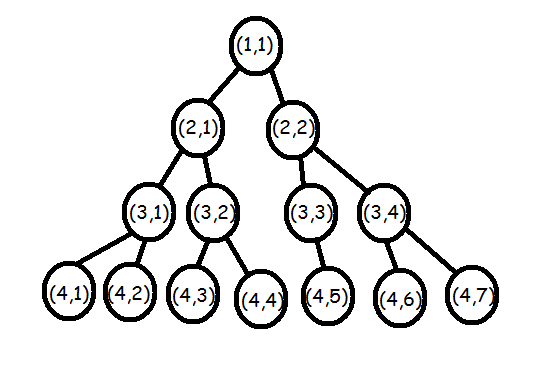Preparando MOJI
Sereja adores trees. Today he came up with a revolutionary new type of binary root trees.
His new tree consists of n levels, each vertex is indexed by two integers: the number of the level and the number of the vertex on the current level. The tree root is at level 1, its index is (1, 1). Here is a pseudo code of tree construction.
//the global data are integer arrays cnt[], left[][], right[][]
cnt[1] = 1;
fill arrays left[][], right[][] with values -1;
for(level = 1; level < n; level = level + 1){
cnt[level + 1] = 0;
for(position = 1; position <= cnt[level]; position = position + 1){
if(the value of position is a power of two){ // that is, 1, 2, 4, 8...
left[level][position] = cnt[level + 1] + 1;
right[level][position] = cnt[level + 1] + 2;
cnt[level + 1] = cnt[level + 1] + 2;
}else{
right[level][position] = cnt[level + 1] + 1;
cnt[level + 1] = cnt[level + 1] + 1;
}
}
}
After the pseudo code is run, cell cnt[level] contains the number of vertices on level level. Cell left[level][position] contains the number of the vertex on the level level + 1, which is the left child of the vertex with index (level, position), or it contains -1, if the vertex doesn't have a left child. Similarly, cell right[level][position] is responsible for the right child. You can see how the tree with n = 4 looks like in the notes.
Serja loves to make things complicated, so he first made a tree and then added an empty set A(level, position) for each vertex. Then Sereja executes m operations. Each operation is of one of the two following types:
Help Sereja execute the operations. In this problem a set contains only distinct values like std::set in C++.
The first line contains integers n and m (1 ≤ n, m ≤ 7000).
Next m lines contain the descriptions of the operations. The operation of the first type is given by five integers: 1 t l r x (1 ≤ t ≤ n; 1 ≤ l ≤ r ≤ cnt[t]; 1 ≤ x ≤ 106). The operation of the second type is given by three integers: 2 t v (1 ≤ t ≤ n; 1 ≤ v ≤ cnt[t]).
For each operation of the second type, print the answer on a single line.
4 5
1 4 4 7 1
1 3 1 2 2
2 1 1
2 4 1
2 3 3
2
0
1
You can find the definitions that are used while working with root trees by this link: http://en.wikipedia.org/wiki/Tree_(graph_theory)
You can see an example of a constructed tree at n = 4 below.
